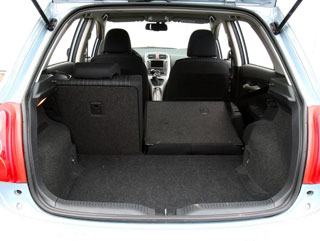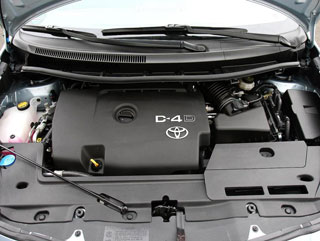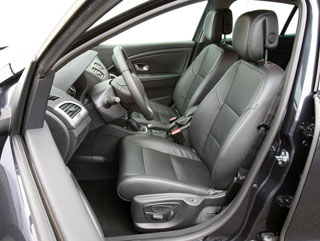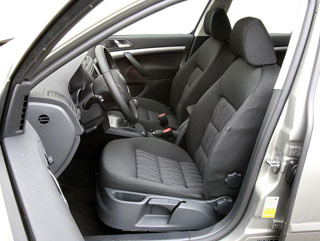Skoda Octavia 2013 - NV sedan test drive
Comparative test: Listing the minuses of the Auris hatchback compared to Golf, Megane and Octavia
 The five -door Renault Megane was born. In a comparative test involving VW Golf, refreshed Skoda Octavia and Toyota Auris, he should show what he is capable of.
The five -door Renault Megane was born. In a comparative test involving VW Golf, refreshed Skoda Octavia and Toyota Auris, he should show what he is capable of. The new Golf is on the crest of a wave of success. After all, it seems that the sixth generation of the craftsman is from Wolfsburg, conquering all the roads, so far no one could win. In the first two comparative tests of the Auto Zeitung publication, the Germans managed to prove his competitiveness.
Now Renault releases a completely new Megane into battle. The third generation of the compact model of the Frenchman in his abilities largely surpasses his predecessor. Moreover, the new Megane boasts a much better quality and less contradictory design philosophy.
But competitors do not sleep, which is proved by recently improved Skoda Octavia. Having in its arsenal a successful model with a honed profile and exquisite content, the Czech partner of the VW concern keeps up to date. The Japanese opponent Golf's name is Toyota auris. The descendant of more than forty years of the produced Corolla appeared on the European market in March 2007. For the first battle with the 5-door Megane, we took economical versions of cars with turbocharged diesel engines with a capacity range from 126 to 140 hp.
On too steep turns, Toyota Auris sins insufficient controllability.
Body
Compared to its avant -garde ancestor, the new Renault Megane looks very nice. The front part resembles the appearance of a more dimensional Laguna, but when sculpting the stern, it seems, the muse left designers. But the 5-door car likes its composite line of the roof, which, however, is at the same time its Achilles fifth: in the compact car, the place in the back seat has become small. And although in terms of convenience there are absolutely no complaints about the rear seat, I would like to have more space space, which, however, applies to the space above the head, which is limited to the arches of the roof on the sides. But passengers of the front seats comfortably feel in deep armchairs, surrounded by soft, pleasant to the touch by the finishing materials of the cockpit.
But the new VW Golf model is a cut above this parameter. The materials used in this car look expensive and carefully processed. Numerous chrome inserts indicate a remarkable love of Wolfsburg designers into details. And even in the sixth generation, the German favorite is still ergonomic, despite the increased number of functions, while the devices control buttons are perfectly visible.
Tightened Renault Megane easily passes at high speed.
In terms of spaciousness, Golf is in no way inferior to Skoda Octavia, which, thanks to its huge luggage compartment and the largest capacity, leaves behind all other rivals. Managing Octavia functions is as simple as in VW, which is not surprising, because both the climate control panel and the system of information and entertainment devices in these cars are identical.
In terms of Toyota Auris ergonomics, there is where to grow. So, the on -board computer is very difficult to reach, since the button is located on the console inconvenient, and the navigation system also takes some time to get used to it. The salon and the luggage compartment are quite spacious. On the front seats, you feel truly free due to the windshield moved forward. But according to the materials of the interior decoration, the Japanese is significantly lagging behind. In vain, you are looking here with pleasant surfaces to the touch, still finishing materials are hastily processed.
 Thus, in this part of the competition, Skoda Octavia wins with a large margin. Auris receives red light, which, however,, like Golf, has an airbag for the knees of the driver in the arsenal.
Thus, in this part of the competition, Skoda Octavia wins with a large margin. Auris receives red light, which, however,, like Golf, has an airbag for the knees of the driver in the arsenal. The rounded feed of the current Megane model makes a less contradictory impression.
Comfort on the road
Here Golf's hour was breaking through. Equipped with the adaptive chassis of DCC (925 euros), in comfort mode (one of three depreciation levels available for selection) confidently smooths out almost all the bumps of the roadway, while it does not matter whether it rides light or loaded. Only transverse seams do not go unnoticed for passengers. But Skoda also gives due impression. Even with full load, this car is not loosened, but the shafts of the body are minimized. The empty Megane rudely jumps on bumps, but its behavior improves markedly with an increase in the load. As for Toyota, then everything is exactly the opposite.
Golf has established itself as an ideal travel car, in which even during long trips you can enjoy increased comfort. Both the front and rear seats VW turned out to be the most convenient. It is worth noting that the car is equipped with sports leather buckets that cost 2,125 euros. In addition, Golf and Renault have the best sound insulation. Octavia, like Auris, lose their competitors in this parameter due to noisy engines.
If we talk about comfort in the car, Toyota loses many points due to the fact that for the stock model for air conditioning you have to pay separately. In addition, the seats cannot boast of the same qualities that rivals have the seats. What is especially annoying is a hard armrest that is located so low that in fact it does not fulfill its function. One way or another, the right hand involuntarily reaches for a more convenient lever of gear shifts, which rises on the middle console.
The advanced OSTAVIA pleases with its flexible character.
Engine and transmission
While the VW TDI two-liter engine operates on a more smooth-smooth Common Rail injection system, the Skoda turbodiesel technically using a pump-record for fuel injection. Differences are manifested in the development of power. In Golf'a, this process proceeds evenly, but Skoda abruptly breaks down from the chain after 1,500 revolutions, but at the upper speeds her breath exhausted. These are the only moments that deserve critics. Indeed, despite the principle of combustion, used in a turbodiesel with a fring pump, Golf is in no way inferior in terms of the characteristics of the Octavia movement. And with a consumption of only 6.2 liters of diesel fuel per 100 km of Skoda, also the most economical.
A strikingly harmonious impression is made by the 1.9-liter DCI Renault motor. Having 130 horses, this engine is exactly ten hp. Weaker, but it is equipped with two valves on the cylinder. The power plant works as smoothly as the Golf engine, it surprises a very harmonious disclosure of potential. That you like less is the relatively less accurate operation of the switch lever
 i have a 6-speed box, as well as the highest fuel consumption of 6.5 liters per hundred, that is, as much as VW consumes.
i have a 6-speed box, as well as the highest fuel consumption of 6.5 liters per hundred, that is, as much as VW consumes. Possessing a capacity of only 126 hp, the 2.0-liter D-4D Toyota engine is the weakest of all participants. Therefore, it is logical that by the characteristics of the Auris movement, it is woven in the tail. The Japanese develops power as smoothly as Renault and VW, but he documents with his constant tapping and truncating.
Under the shell of the Czech sedan with an inclined stern is hidden by the technical filling of VW.
Dynamics
The adaptive chassis mentioned above turns Golf into ACA in terms of dynamics. The steering wheel works for sure, the German turns around only with a minimum disadvantage. On too steep winds of the road, the car is very gently and almost imperceptibly for passengers is slowed down by the ESP system, which does not completely turn off. Small suits, typical of Skoda, Renault and Toyota, are practically not familiar to the Germans. And with the brake route of about 36 meters, it rose quite high on the grade scale.
The fact that the Golf track is inferior to the Frenchman Renault with a weaker engine is explained by his too long gears. After all, Renault is surprisingly obediently and confidently passing turns, although it has significantly improved in comparison with its predecessors has not yet reached the level of accuracy and information content that is characterized by its opponent from Wolfsburg.
More precisely, it reacts to the turns of the steering wheel Skoda, but it shows itself worse when moving in a straight line than VW. Therefore, due to the necessary correction of the steering wheel turns, the Czech car misses points.
In this round, Toyota is hardly able to compete. This is due, along with its weaker motor, also with too pronounced insufficient controllability and unexpectedly serval drive of the steering wheel. Because of this, the Japanese gives the impression of an uncontrollable car, although in reality this is not at all the case. At the same time, his system of course stability gives him less freedom than the ESP competitors, since it begins to slow down the machine noticeably earlier.
Thanks to the information content of the steering wheel, VW is precisely controlled.
 Prices
Prices At the cost of Toyota, it turns out to be the cheapest car from the four rivals, and only a three -year guarantee is offered for it. In addition, in four years he loses the least of all his competitors in price. But still, the basic configuration has a rather modest list of equipment, and the list of options does not look big. At the other end of the scale is Golf, the base value of which is 24,850 euros, which in general prevents it from calling it truly a folk car, although there is all the necessary equipment on board. True, there were no xenon headlights on models produced until this spring.
MEGANE and AURIS do not provide an automatic gearbox, and this is a very profitable investment, given the need for constant stops when moving in the city. But Octavia is no longer as profitable as it might seem if you rely only on its reputation. Renault is beneficial in all respects, except for visits to the workshop, which undoubtedly goes much more money, moreover, the Frenchman loses the most in value. So there can be no question of the victory of Renault in this part of the competition.
Note from Drom.ru. In Russia, Toyota Auris in the most affordable version (1.4 liters, manual transmission) costs $ 21,800 (679,704 rubles) or 588,600 rubles for the 2008 car of the release under a special promotion. The sixth generation Golf with a 1.6-liter engine and mechanics is estimated at least 591,828 rubles. Octavia in a notchback body, according to the data from the official Skoda website, in the base version with a 1.4-liter engine and mechanical crumbs costs 579,000 rubles. The new generation of Megane in the back of the hatchback has not yet reached Russia, and the old one costs from 550,500 rubles.
Golf is comfortable and characterized by confident behavior.
Conclusion
It seems that no one will pass by VW Golf. The victory in this comparative test passes to the Germans with his ability to conquer any roads. Although the practical and spacious Skoda Octavia follows it on the heels. The frisky Renault Megane took third place. He loses many points, mainly due to tightness in the back seat. For Toyota Auris, only the fourth position remained. In all respects, the Japanese can offer at best the average option.
























Source: Autozeitung.de











